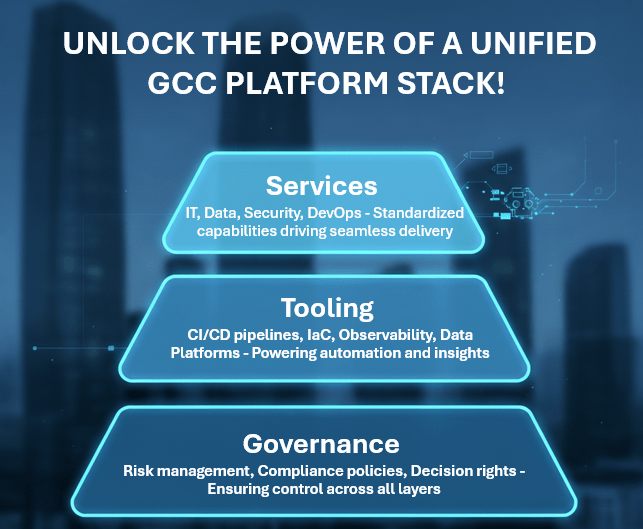Choosing the Right GCC Platform Operating Model: A Practical Guide
Leading enterprises are increasing their investments in Global Capability Centers (GCCs) as they continue to digitize. Instead of managing services, tools, and governance in separate silos, they are adopting flexible models. These new frameworks align with their broader digital transformation goals, allowing for greater scalability and more effective risk management. This layered approach strengthens delivery and improves resource reuse.
The right GCC platform operating model shifts the center from fragmented efforts into structured systems that scale across global operations. It also impacts talent outcomes by driving adoption and skill development.
What is a GCC Platform Operating Model?
A GCC platform operating model defines how services, tools, and governance interact holistically and outlines a structured approach that scales efficiently while supporting agility and consistent outcomes. A GCC platform operating model clarifies ownership, roles, and accountability across multiple business and technology layers.
Definition and Scope across Services, Tooling, Governance
Services define the capabilities and workflows the GCC provides to enable global teams. Tooling refers to standardized stacks for delivery, automation, security, and data-driven adoption management. Governance defines accountability, oversight, policy adherence, and mechanisms for compliance across functions. Together, these layers extend the model’s scope by balancing organization-wide scale with local customization.

Why Platform Alignment Matters for Reuse and Speed
Platform alignment ensures delivery teams have access to consistent services, reducing inefficiencies and duplicated investments. It drives reuse of capabilities, which improves cost transparency and accelerates enterprise speed. Alignment allows talent to leverage standardized playbooks, creating predictability across multiple business functions.
Services Layer: What the Platform Provides
The services layer defines the capabilities a GCC makes available across the enterprise. It provides standardized offerings that internal teams can adopt, streamlining delivery while promoting efficiency and reuse.
Shared Services Catalog (IT, Data, Security, DevOps)
A services catalog centralizes critical offerings, from IT infrastructure and data management to DevOps. Standardization ensures there is less fragmentation, and teams gain reliable services with predictable quality levels.
Product-aligned Enablement (COEs, Internal Platforms)
Centers of Excellence (COEs) and internal product platforms align services with business outcomes. They enable teams by providing domain-specific expertise, best practices, and reusable assets.
Service Tiers, SLAs, and Intake Workflows
Service tiers define levels of support aligned with varying enterprise needs. SLAs clarify quality expectations through measurable commitments across speed, reliability, and responsiveness. On the other hand, intake workflows provide structure, ensuring requests are prioritized, processed, and fulfilled consistently.
Tooling Layer: The Standardized Tech Stack
The tooling layer supplies the common platforms and solutions that accelerate delivery. It creates efficiency by reducing duplicated investments and aligning teams on preferred stacks. Consistency in tooling strengthens adoption, supports transparency, and drives delivery reliability at scale.
DevEx Toolchain (CI/CD, IaC, SRE, Observability)
Developer Experience stacks cover automation tools like CI/CD pipelines, infrastructure as code, and SRE. Observability solutions are integrated to improve monitoring, feedback loops, and system reliability.
Data Platform and BI Standards (Governed Access, Lineage)
A standardized data platform enforces consistent access control, lineage tracking, and analytical workflows. Business intelligence standards ensure data is reliable, usable, and compliant while enabling informed decisions.
Security and Compliance Guardrails (IAM, DLP, Secrets)
Security tooling defines guardrails around identity management, data loss prevention, and secrets handling. These controls create protection without slowing delivery, balancing agility with compliance requirements.
Governance Layer: How Decisions and Risks are Managed
Governance layer clarifies how decisions are made, how risk is handled, and how costs are allocated. It ensures that the platform operates within a controlled and accountable framework. This layer reduces uncertainty and provides enterprise-wide trust in the platform’s ownership model.
Operating Cadence (QBRs, RACI, Decision Rights)
Structured operating routines define how performance is reviewed and responsibilities are assigned. Mechanisms like QBRs, RACI charts, and decision rights provide clarity and accountability across roles.
Risk and Compliance (Policies, Audits, Data Residency)
Policies and audits ensure that enterprise standards and regulatory requirements are maintained. Data residency and compliance safeguards protect sensitive information while meeting regional requirements.
Cost Allocation and Chargeback Models
Cost models distribute expenses transparently, attributing resource usage directly to consuming teams. Chargebacks encourage accountability and efficient use of shared services while improving financial governance.
Layered Architecture that Scales
A GCC platform operating model uses a layered architecture that balances scale and flexibility. The foundation layer sets core standards, ensuring baseline capabilities exist across enterprise workflows. System and leveraged layers extend functionality, supporting efficiency through common reusable capabilities.
Differentiated layers introduce specialized services and sector-specific enhancements for business advantage. Finally, personalization allows tailoring for unique team or regional requirements without breaking standards. Each layer has a defined role in scaling consistently without unnecessary complexity. This structure helps organizations avoid duplication while sustaining speed, control, and adaptability.
Reuse vs Customization: Rules of Engagement
Clear rules distinguish when reuse is required and when customization is permitted. This ensures efficiency is balanced with flexibility to meet business-specific requirements.
KPIs that Prove Value
KPIs show stakeholders the platform’s success through adoption, speed, reliability, and efficiency. Cycle time reductions highlight delivery improvements, while cost-to-serve measures financial outcomes. Talent-related metrics focus on enablement, skill growth, and reuse of COE outputs. They demonstrate human capital development as an enterprise benefit of platform adoption.
Implementation Checklist
A successful GCC platform operating model requires an implementation checklist that ensures structured execution. The services catalog defines available offerings, creating clarity for teams across enterprise functions.
Reference architectures provide proven blueprints that guide delivery with consistency and reduced complexity. Policy packs embed necessary compliance safeguards, enabling secure operations without slowing innovation cycles. Platform product teams take responsibility for designing, maintaining, and continually evolving platform services.
Enablement playbooks train teams, standardize adoption practices, and accelerate maturity across multiple functions. Together, these elements drive predictable implementation, ensuring efficiency, resilience, and scalability in platform operations.




